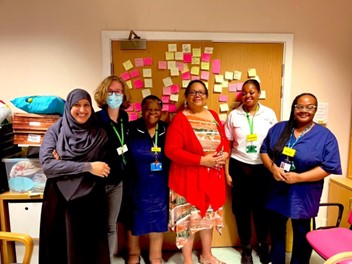
Reducing Falls on Sally Sherman Ward
14th June 2024
By Rosca Marange (Ward Manager), Tracy Connellan (Interim Deputy Lead Nurse), Happy Khatun (Activities Manager), Ngalita Mbelo (Inpatient Therapies Clinical Lead) and Clarissa Sørlie (Improvement Advisor)
In September 2022, Sally Sherman ward identified that they had the highest number of falls in the Trust. The ward provides continuing care to people who have dementia and complex needs, so these findings were unsurprising: people with dementia are at higher risk of falls due to a range of factors including muscle weakness, poor balance and visual impairment, and falls are the most frequently reported patient safety incident in hospitals (Office for Health Improvement and Disparities, 2022). However, the team were determined to improve safety on their ward, recognising the devastating impact that falls can have for patients and their loved ones.
Led by Ngalita (Maggy) Mbelo (inpatient therapies clinical lead and falls specialist) and Chantal Riviere (modern matron), the team joined the Trust-wide therapeutic engagement event and decided to aim for a 30% reduction in falls rate and 20 days between falls, based on results from a national falls improvement collaborative across 19 Trusts in 2017 (NHS Improvement, 2018). This was a great opportunity for collaborative work between inpatient nursing and allied health professionals, including activities. Speaking about the project, Maggy said, “as a falls specialist, doing this project was vital to preventing functional decline and promoting safe mobility.”
 Figure 1. Initial project team from right to left: Happy Khatun (occupational therapist and activities manager), Dr Marta Dugonjic (ward doctor), Rosca Marange (ward manager), Chantal Riviere (modern matron), Stephanie Ajiboye (occupational therapist) and Alison McFarlane (occupational therapy assistant). Not pictured: Maggy Mbelo (Inpatient Therapies Clinical Lead)
Figure 1. Initial project team from right to left: Happy Khatun (occupational therapist and activities manager), Dr Marta Dugonjic (ward doctor), Rosca Marange (ward manager), Chantal Riviere (modern matron), Stephanie Ajiboye (occupational therapist) and Alison McFarlane (occupational therapy assistant). Not pictured: Maggy Mbelo (Inpatient Therapies Clinical Lead)
To help them understand the problem, the team reviewed incident reports from the previous two years and developed a Pareto Chart (see Figure 2) to visualise the frequency with which themes occurred. The results surprised them. Almost 50% of incidents were unwitnessed, suggesting that they needed to improve the quality of their nursing observations. Agitation accounted for a further 18% of falls, so the team recognised that this would be another key area for improvement.
 Figure 2. Pareto chart for the themes of falls incidents
Figure 2. Pareto chart for the themes of falls incidents
The team also completed a cause-and-effect diagram (see Figure 3) to further understand the complexity of reasons behind the high rate of falls.
Figure 3. Cause and effect diagram
Using a driver diagram (see Figure 4), the team captured their theory of change, identifying key drivers of skilled and supported staff, effective MDT working, therapeutic engagement and environmental changes.
Figure 4. Driver diagram visualising the team’s theory of change
The team tested a range of ideas, starting with personalised activity boxes, which Happy Khatun identified as a way ” to engage patients in therapeutic, person-centred, meaningful activities”. Other change ideas included spot checks on nursing observation, recruitment of volunteers and the creation of wall murals. After 16 months of testing, the team were astounded to see a sustained 74% decrease in falls rate from 5.4 to 1.4 per month. The team continued to track time between falls and have recently gone 112 days without a fall, a significant improvement from their baseline of 5 days between falls.
 Figure 3. Control chart showing a decrease in average monthly falls rate
Figure 3. Control chart showing a decrease in average monthly falls rate
Tracy Connellan (Interim Deputy Lead Nurse) has recently taken on leadership of the project, and new members have joined the team, increasing representation from admin, housekeeping, pharmacy, physiotherapy, psychiatry, and nursing. Between them, this newly formed team have many more theories and ideas that they want to test to keep falls low on the ward and continue to improve quality of engagement.
 Figure 4. Current project team pictured in front of one of the new ward murals.
Figure 4. Current project team pictured in front of one of the new ward murals.
Left to right: Sarah Sinclair (ward clerk), Abimbola Akinbola (healthcare assistant), Nathaniel Addo (clinical lead pharmacist), Rosca Marange (ward manager), Tracy Connellan (interim deputy lead nurse), Dr Caroline Methuen (consultant psychiatrist), Stephanie Ajiboye (occupational therapist), Alison McFarlane (occupational therapy assistant), Amanda Piper (ward housekeeper) and Dr Curtis Osborne (ward doctor)
References:
NHS Improvement (2018) ‘NHS Improvement: 2017/18 Highlights’. Available online: https://www.england.nhs.uk/wp-content/uploads/2019/09/NHS_Improvement_2017_18_highlights.pdf (Accessed: 15th May 2024)
Office for Health Improvement and Disparities (2022) ‘Falls: Applying All Our Health’. Available online: https://www.gov.uk/government/publications/falls-applying-all-our-health/falls-applying-all-our-health (Accessed: 15th May 2024)
Most Read Stories
-
Why is Quality Control important?
18th July 2018

-
An Illustrated Guide to Quality Improvement
20th May 2019

-
2016 QI Conference Poster Presentations
22nd March 2016
-
Recognising Racism: Using QI to Help Take Action
21st January 2021

-
Using data enabled us to understand our problem
31st March 2023

-
QI Essentials: What does a Chief Quality Officer do?
18th March 2019


Follow QI on social media
To keep up to date on the latest concerning QI at ELFT, follow us on our socials.




